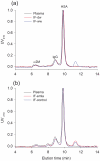Effect of topical anaesthetics on interstitial colloid osmotic pressure in human subcutaneous tissue sampled by wick technique
- PMID: 22348071
- PMCID: PMC3279369
- DOI: 10.1371/journal.pone.0031332
Effect of topical anaesthetics on interstitial colloid osmotic pressure in human subcutaneous tissue sampled by wick technique
Abstract
Objectives: To measure colloid osmotic pressure in interstitial fluid (COP(i)) from human subcutaneous tissue with the modified wick technique in order to determine influence of topical application of anaesthetics, dry vs. wet wick and implantation time on COP(i).
Material and methods: In 50 healthy volunteers interstitial fluid (IF) was collected by subcutaneous implantation of multi-filamentous nylon wicks. Study subjects were allocated to two groups; one for comparing COP(i) obtained from dry and saline soaked wicks, and one for comparing COP(i) from unanaesthetized skin, and skin after application of a eutectic mixture of local anaesthetic (EMLA®, Astra Zeneca) cream. IF was sampled from the skin of the shoulders, and implantation time was 30, 60, 75, 90 and 120 min. Colloid osmotic pressure was measured with a colloid osmometer. Pain assessment during the procedure was compared for EMLA cream and no topical anaesthesia using a visual analogue scale (VAS) in a subgroup of 10 subjects.
Results: There were no significant differences between COP(i) obtained from dry compared to wet wicks, except that the values after 75 and 90 min. were somewhat higher for the dry wicks. Topical anaesthesia with EMLA cream did not affect COP(i) values. COP(i) decreased from 30 to 75 min. of implantation (23.2 ± 4.4 mmHg to 19.6 ± 2.9 mmHg, p = 0.008) and subsequently tended to increase until 120 min. EMLA cream resulted in significant lower VAS score for the procedure.
Conclusion: COP(i) from subcutaneous tissue was easily obtained and fluid harvesting was well tolerated when topical anaesthetic was used. The difference in COP(i) assessed by dry and wet wicks between 75 min. and 90 min. of implantation was in accordance with previous reports. The use of topical analgesia did not influence COP(i) and topical analgesia may make the wick technique more acceptable for subjects who dislike technical procedures, including children.
Trial registration: ClinicalTrials.gov NCT01044979.
Conflict of interest statement
Figures

 ) and between dry wicks from 30 to 75 min. with (
) and between dry wicks from 30 to 75 min. with ( ).
).

Similar articles
-
Interstitial fluid colloid osmotic pressure in healthy children.PLoS One. 2015 Apr 8;10(4):e0122779. doi: 10.1371/journal.pone.0122779. eCollection 2015. PLoS One. 2015. PMID: 25853713 Free PMC article. Clinical Trial.
-
Colloid osmotic pressure of interstitial fluid in rat subcutis and skeletal muscle: comparison of various wick sampling techniques.Acta Physiol Scand. 1988 Jun;133(2):167-75. doi: 10.1111/j.1748-1716.1988.tb08396.x. Acta Physiol Scand. 1988. PMID: 3227913
-
Colloid osmotic pressure of human subcutaneous interstitial fluid sampled by nylon wicks: evaluation of the method.Scand J Clin Lab Invest. 1982 Apr;42(2):123-30. Scand J Clin Lab Invest. 1982. PMID: 7134796
-
Eutectic lidocaine/prilocaine cream. A review of the topical anaesthetic/analgesic efficacy of a eutectic mixture of local anaesthetics (EMLA).Drugs. 1993 Jul;46(1):126-51. doi: 10.2165/00003495-199346010-00008. Drugs. 1993. PMID: 7691503 Review.
-
Review of neoplastic mimics in dermatopathology, by mark R. Wick and james w. Patterson.Dermatol Pract Concept. 2013 Jul 31;3(3):31-4. doi: 10.5826/dpc.0303a09. Dermatol Pract Concept. 2013. PMID: 24106660 Free PMC article. Review. No abstract available.
Cited by
-
Cell blebbing upon addition of cryoprotectants: a self-protection mechanism.PLoS One. 2015 Apr 13;10(4):e0125746. doi: 10.1371/journal.pone.0125746. eCollection 2015. PLoS One. 2015. PMID: 25875076 Free PMC article.
-
Transcapillary fluid flux and inflammatory response during neonatal therapeutic hypothermia: an open, longitudinal, observational study.BMC Pediatr. 2018 Feb 23;18(1):82. doi: 10.1186/s12887-018-1020-3. BMC Pediatr. 2018. PMID: 29471782 Free PMC article.
-
Interstitial fluid colloid osmotic pressure in healthy children.PLoS One. 2015 Apr 8;10(4):e0122779. doi: 10.1371/journal.pone.0122779. eCollection 2015. PLoS One. 2015. PMID: 25853713 Free PMC article. Clinical Trial.
References
-
- Fadnes HO, Reed RK, Aukland K. Mechanisms regulating interstitial fluid volume. Lymphology. 1978;11:165–169. - PubMed
-
- Aukland K, Fadnes HO. Protein concentration of interstitial fluid collected from rat skin by a wick method. Acta Physiol Scand. 1973;88:350–358. - PubMed
-
- Fadnes H, Aukland K. Protein concentration and colloid osmotic pressure of interstitial fluid collected by the wick technicue: Analysis and evaluation of the method. Microvascular Research. 1977;14:11–25. - PubMed
-
- Wiig H, Heir S, Aukland K. Colloid osmotic pressure of interstitial fluid in rat subcutis and skeletal muscle: comparison of various wick sampling techniques. Acta Physiol Scand. 1988;133:167–175. - PubMed
Publication types
MeSH terms
Substances
Associated data
LinkOut - more resources
Full Text Sources
Medical
Miscellaneous

